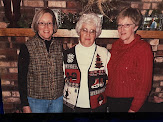by Mary Reiman
We were never going to be ready. For 99 years she brought joy and goodness to the lives of everyone she met. We can’t imagine our world without her in it. Thanks to her kindness and generous spirit, we learned what is really important in life.
Mom passed away last week. We know she is already in heaven fixing roast beef, scalloped corn, mashed potatoes and gravy, with peach pie for dessert, as she did for the men baling hay and picking corn. If anyone deserved to go to heaven, it’s our mom. She didn’t have a middle name, so we lovingly gave her one: Bug. She was our Junebug and the nursing home staff affectionately called her Junebug as well.
Her days were spent in the kitchen baking, preparing meals, and taking snacks to the men in the field at 10 a.m. and 3:00 p.m. In-between those hours there was mowing the yard, walking beans, doing the laundry with a ringer washer, taking those heavy loads of laundry up the steps to the clothesline outside and doing everything else asked of her. But when we got home from school every day, she was back in the kitchen waiting for us to tell her about our day…as if she had been there waiting for us all day.
There are so many stories we could share about her. We could talk about how many games of Yahtzee we played or how many jigsaw puzzles we put together. We could talk about how many pies, cakes, cookies, jello salads and casseroles she made over the years. We could talk about how many letters she wrote and how many cards she sent...and who received the funniest one. No doubt she kept Hallmark in business for many years!
In 1983, I gave her a blank book and asked her to write some of her life stories. She returned it to me in 1994. I hear her voice in every word I read. It began “All the wonders of nature, change of seasons and new creations of our Lord and Father makes us thankful we have always been plain country folks. There is great joy and satisfaction in preparing the soil, planting, waiting for it to come up, to grow and to mature to the harvest stage.”
She grew up in the depression, the youngest of five children. “It was a small farmhouse with just 2 bedrooms, but Mom and Dad, one sister, 3 brothers, and a hired man managed to find a place to sleep and eat and we all grew up learning to love the river, hills, trees, cattle and learning what hard work meant!”“We had a wood and coal range for cooking and a pot belly wood and coal heater in the living room...We always kept the basement full of split wood and coal. It was my job each night after school to fill the wood boxes which were kept behind each stove. Then I filled the hot water reservoir on the range. The water was carried from an outside pump house and pumped by hand. Always on Sunday night I filled the boiler, which was heated on the range, for Monday’s laundry. The soiled white shirt collars and soiled dish towels were soaked overnight to remove any spots, so they would be sparkly white when hung on the line. The clothes would freeze stiff when hung on the line in winter and later brought inside to finish drying on a wooden clothes rack near the heating stove.”
“My mom often went with Grandpa to buy cattle in my years from 7-12 grades, so I prepared a lot of suppers. We had a cold back porch where we kept fresh beef and pork in the winter. I would take the meat saw and cut whatever we wanted for supper, usually pork chops or round steak.”
“My folks first radio was an ‘Atwater Kent’ brand with a big horn type speaker. My dad would have to coax me with a penny or a nickel to go downstairs each morning and write down the cattle and hog receipts at the major markets. They came over the Yankton or Sioux City station.”“When and where I grew up west of Milford, we had great hills for sliding. We would take an old piece of corrugated tin, turn the end up and put a rope on it and use it for our sled. The winter of 1936 was our heaviest snow ever. We walked out the back door and had to cut steps in the packed snow and walk to the pump house for water, where we made steps again to get down to the pump. We were always afraid of slipping on the packed snow as we had a pail of water in each hand.”
Mom and dad were married in 1947. She wrote: “Our first house was very old, no electricity or inside plumbing, but it had a lot of warmth and character and we both loved it. That is where Cindy was born...We hated to leave our home, but my folks bought the farm and wanted to move there and Barney’s folks had just retired.”
So they moved to the Reiman homestead where Cindy and I grew up. The stories of our childhood filled many more pages. Our memories fill us with joy and gratitude.
Yes, we miss her greatly. But her spirit lives on in all of us.
The last sentence in her book says it all: “When I am gone, I want you to grieve but a short time and then talk about the memories. Keep me in circulation!”
Oh mom...we will.













